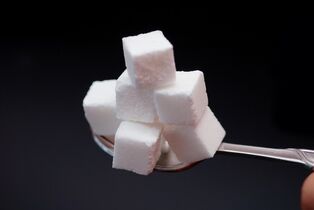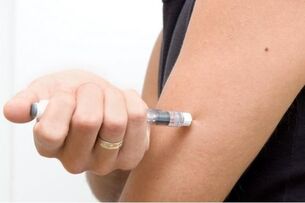
Diabetes is a chronic disease characterized by metabolic disorders caused by absolute or relative lack of insulin. The pancreas is the only organ, weighing 70-100 grams, located in the abdominal cavity of the duodenum arch. It plays an important role in the digestion of proteins, fats and carbohydrates. It also produces insulin, which helps to regulate carbohydrate metabolism in the body. In the article, we will cover what nutrition should include in diabetes.
Types of diabetes
Doctors distinguish several types of diabetes, by its cause and course:
- type I diabetes, insulin dependent;
- type II diabetes often occurs later in life, especially in obese patients.
Type I diabetes is often the result of damage to the pancreas. That is, primary damage to beta cells (insulin-producing cells in the pancreas) and an absolute deficiency in insulin secretion.
The early signs of type I diabetes are intense thirst and hunger, unexplained weight loss, frequent urination, blurred vision, fatigue, and chronic infection. In some cases, the onset is accompanied by convulsions, confusion, slurred speech, loss of consciousness. Type I diabetes is considered to be an immune pathology.
Type II diabetes is more common in obese people. The disease can be congenital or acquired and is characterized by a decrease in pancreatic insulin secretion, as well as insulin resistance. This means that even the right amount of insulin in the body cannot complete the task.
The disease is accompanied by increased thirst and urination, and slowly increased blood sugar. The patient feels weak and sleepy. The disease usually begins in the middle and the elderly. However, in recent years, the number of young patients with type II diabetes has increased dramatically. And a large number of children and adolescents are at an alarmingly overweight and obese level.
What is hyperglycemia

Hyperglycemia - blood sugar level above normal. Symptoms of hyperglycemia include thirst, dry mouth, excessive urination, weight loss, and daytime sleepiness.
The most common cause of hyperglycemia is undiagnosed or poorly controlled diabetes. In people with diabetes, this condition can occur from not enough insulin.
Less often, hyperglycemia is the result of infectious and endocrine diseases (hyperkeratosis, Cushing's syndrome). There is a greater risk of developing late complications, especially on the cardiovascular system.
Chronic hyperglycemia is associated with dysfunction and malfunction of various organs - the eyes, kidneys, nerves, heart and blood vessels.
The right nutrition for diabetes
In the prevention of diabetes, diet is a very important part of therapy. It is necessary to maintain proper blood glucose and lipid levels and optimal blood pressure. A well-chosen diet reduces the risk of developing complications of diabetes and minimizes the risk of developing vascular disease. A proper diet for diabetes plays an important role in the prevention and treatment of the chronic complications of diabetes. This includes microvascular complications, retinopathy, kidney disease, diabetic neuropathy and others.
Diabetic diet is one of the main factors influencing diabetes outcome.
Sugar is essential to life, but in this case you'd better get rid of the sugar bowl! In diabetes, the metabolism of mainly carbohydrates is impaired. People diagnosed with diabetes should limit their sugar or carbohydrate intake.

Line:
- monosaccharide - glucose and fructose found in fruit and honey;
- sucrose disaccharide is the sugar from a bowl of sugar;
- polysaccharides - flour, pastries, biscuits and bread products, potatoes, bananas, noodles, dumplings, pasta, pancakes and more.
Diabetic Carbohydrates
Carbohydrates are a part of our diet. Their consumption should meet 55-60% of total demand. Depends heavily on the form and structure of the carbohydrate source. Carbohydrates in the digestive tract are digested and broken down into simple sugars - mainly glucose.
Please note that excess carbohydrates induce the constant stimulation of beta cells in the pancreas to produce and secrete insulin.
As our sugar levels go up, our pancreas releases insulin. Insulin is a hormone that allows glucose to enter cells. Simple sugars, like glucose, are quickly transported into the cells in about an hour.
Unfortunately, insulin is a hormone that lasts a few hours and doesn't like being "stopped". Consequently, elevated insulin levels cause fluctuations in blood sugar levels and a feeling of carbohydrate hunger.
A hungry man opens the refrigerator and starts eating to satisfy this hunger. The adrenal glands receive information: fluctuations in blood glucose. All of these responses signal the adrenal glands to secrete adrenaline. This creates a vicious cycle that leads to stress, depression, and autonomic nervousness (neurasthenia).
Therefore, you should minimize carbohydrate intake. In such situations, fluctuations in blood sugar levels and overproduction of the hormones insulin and adrenaline will not occur.

Glucose passes through the walls of the digestive tract and follows the bloodstream into various organs where it is converted and becomes a source of energy. In the case of inadequate exercise, the need for energy is reduced, glucose is stored as glycogen in the muscle and liver.
When in excess, glycogen is converted to fat, leading to fatty liver, as well as accumulation of extra fat in the body. The metabolism of glucose is controlled by insulin, a hormone produced in the pancreas.
Carbohydrates are the main energy materials that can only enter cells with the help of insulin, which distributes simple sugars in the body. However, insulin deficiency, for example, causes an increase in blood sugar, which leads to severe cell metabolism. Lack of insulin in general leads to diabetes in children and young people - type I diabetes.
Diabetic protein
Protein should cover 10-15% of your energy needs. Larger amounts are required for children during growth, for pregnant women. Most valuable - animal protein found in lean meats, cheese, eggs and yogurt.
Since our bodies can produce 56 g of sugar per 100 g of protein, it is important to limit eating more protein. In order not to harm the body, you need to eat high-quality protein (yolks, meat offal). Good sources of plant protein are - soybeans, legumes, whole wheat black bread.
Diabetic diet should and shouldn't
In the diabetic diet, the first stage of treatment should include foods such as egg yolks, butter, yogurt, milk and unsweetened vegetables.
At this point, significantly reduce or eliminate them from the diet: egg whites, lean meats, fish, poultry and nuts.
People with diabetes should not eat high-protein meals or meals at night. At night, the body cannot use it. Since the pancreas does not secrete enough insulin, blood sugar levels rise in the morning. In this case, a dinner consisting mostly of carbohydrates and fats is recommended.
Fat contains the most calories. They can only cover 30% of the daily energy consumption. In excess, they contribute to the development of obesity.
Spices such as cinnamon, garlic, cloves, turmeric and bay leaf lower cholesterol and blood sugar.
Can diabetics eat fruits and vegetables? Yes, as they are a rich source of vitamins and minerals. Fresh vegetables, including broccoli, are ideal foods for diabetics as they are excellent sources of chromium. One onion can release insulin. Potatoes (boiled potatoes raise blood sugar too quickly), asparagus, raw carrots, fresh cucumbers, sauerkraut, elderberry leaves and stem tea, garlic

Vegetables you can eat without significant restrictions:
- tomatoes;
- pickled and fresh cucumbers;
- raw and sauerkraut;
- chicory;
- moat;
- radish;
- chili powder;
- lettuce
- mushrooms;
- zucchini.
An excellent anti-diabetes agent - fresh blueberry leaves, harvested before the fruit is ripe. Blueberries May Prevent Diabetic Retinopathy - Studies have shown significant improvements in vision in people with diabetic eye disease. The disease leads to changes in the background, which dramatically decrease blood flow to the eye.
Overweight diabetics (BMI over 25) should limit caloric intake to lose weight.
The glycemic index of foods
Blood sugar is not only affected by the amount of carbohydrates but also by their type. Therefore, it is necessary to control the quantity and quality of carbohydrates in the diet, but also the glycemic index of the product should be calculated.
Low GI foods are slowly digested and absorbed, do not raise blood glucose quickly and do not stimulate insulin secretion. A low GI diet reduces the risk of developing insulin-dependent diabetes.
The higher the GI value of a food, the higher will be the blood sugar level after consuming that food. Foods with a high GI such as blood sugar. Slow absorption and gradual hyperglycemia after eating foods with low GI helps control blood sugar in diabetics. It is best to eat foods with a GI below 60.
The GI of a food is significantly lower when consumed in its natural form, that is, raw and unprocessed.
Diabetics are also advised to abstain from alcohol.














































































